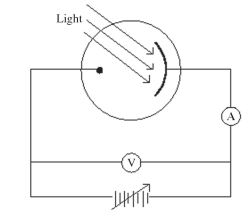Multiple Choice
Monochromatic light is incident on a metal surface, and the ejected electrons give rise to a current in the circuit shown in the figure. The maximum kinetic energy of the ejected electrons is determined by applying a reverse ('stopping') potential, sufficient to reduce the current in the ammeter to zero. If the intensity of the incident light is increased, how will the required stopping potential change? 
A) It will remain unchanged.
B) It will increase.
C) It will decrease.
Correct Answer:

Verified
Correct Answer:
Verified
Q10: If an electron has the same de
Q18: If the work function of a metal
Q26: Find the de Broglie wavelength of
Q29: A photocathode having a work function of
Q31: A monochromatic light beam is incident on
Q33: A laser emits a pulse of
Q36: If an electron has a wavelength of
Q36: A crystal diffracts a beam of electrons,
Q51: An electron is moving with the speed
Q86: Light with a frequency of 8.70 ×